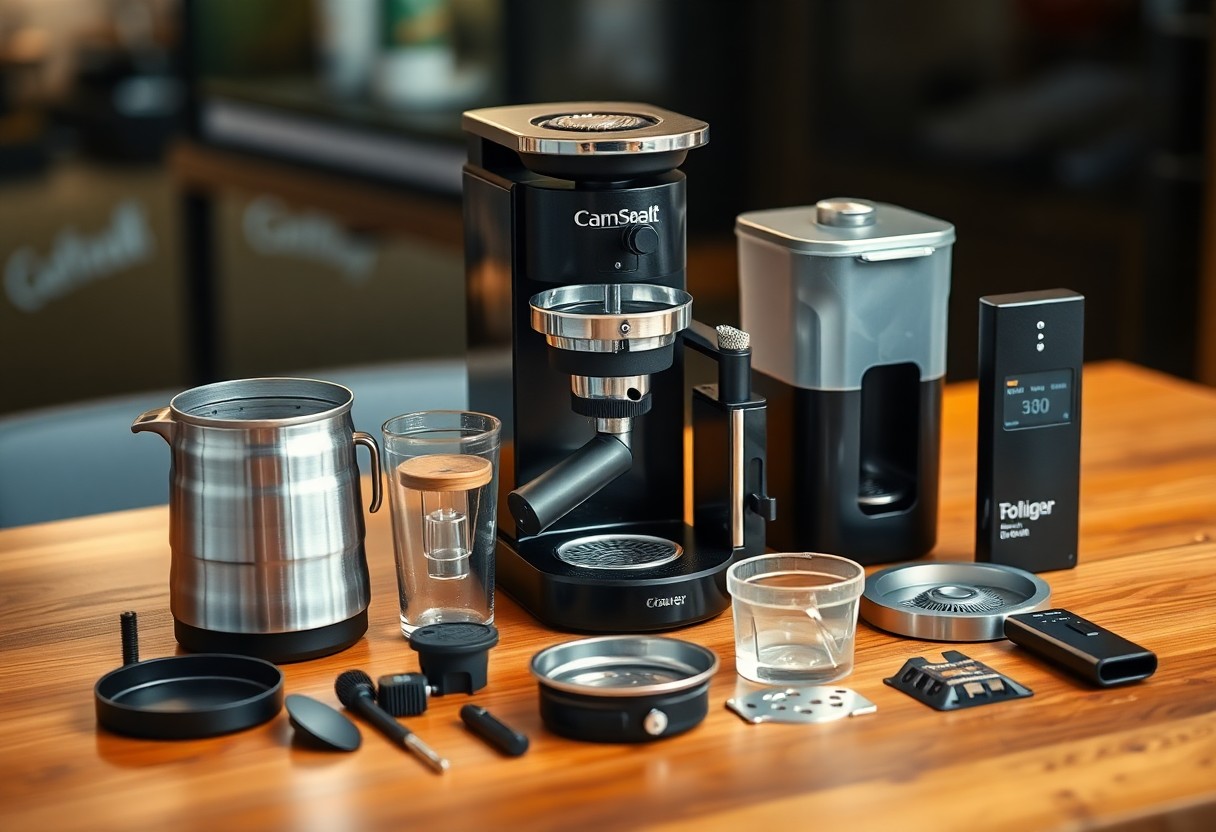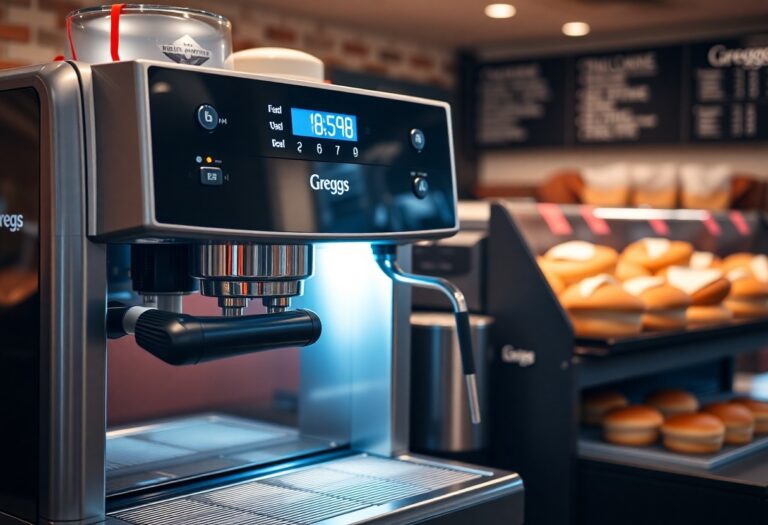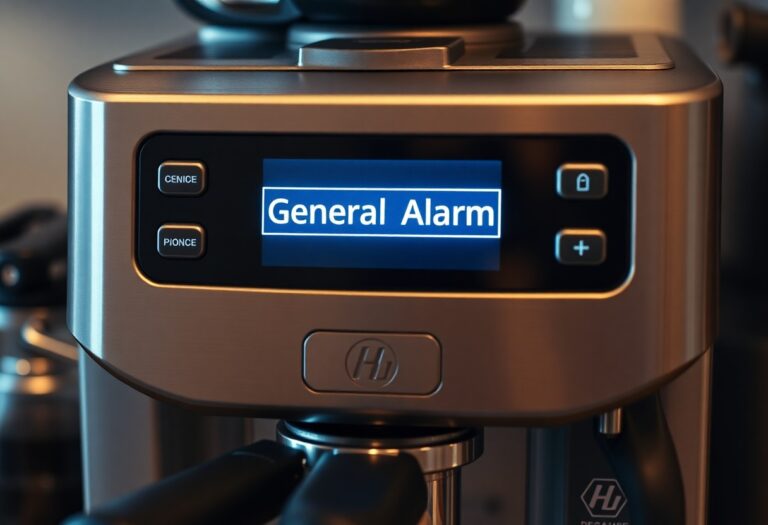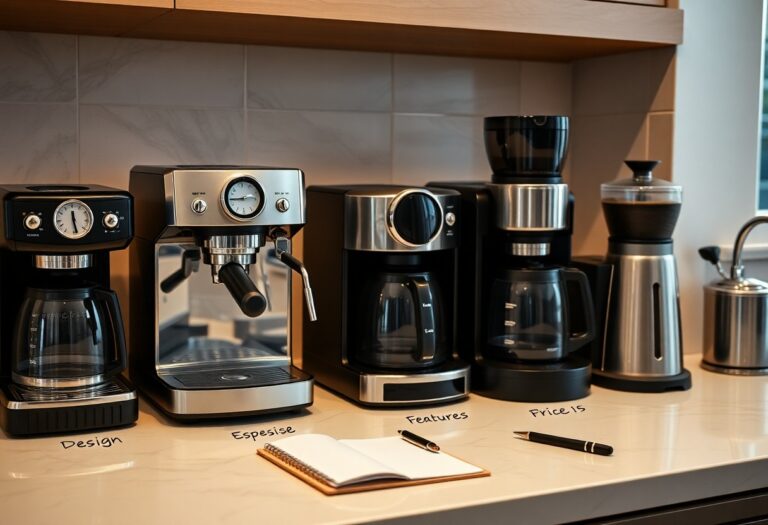What are the Parts of a Coffee Machine Called – Component Names
With your love for coffee, understanding the various components of a coffee machine can enhance your brewing experience. Each part, from the water reservoir to the brew group, plays a vital role in ensuring that you enjoy the perfect cup. Knowing the functions of these components not only empowers you to troubleshoot when problems arise but also helps you appreciate the art and science behind your beloved beverage. Let’s examine into the imperative parts of your coffee machine and what makes each one significant.
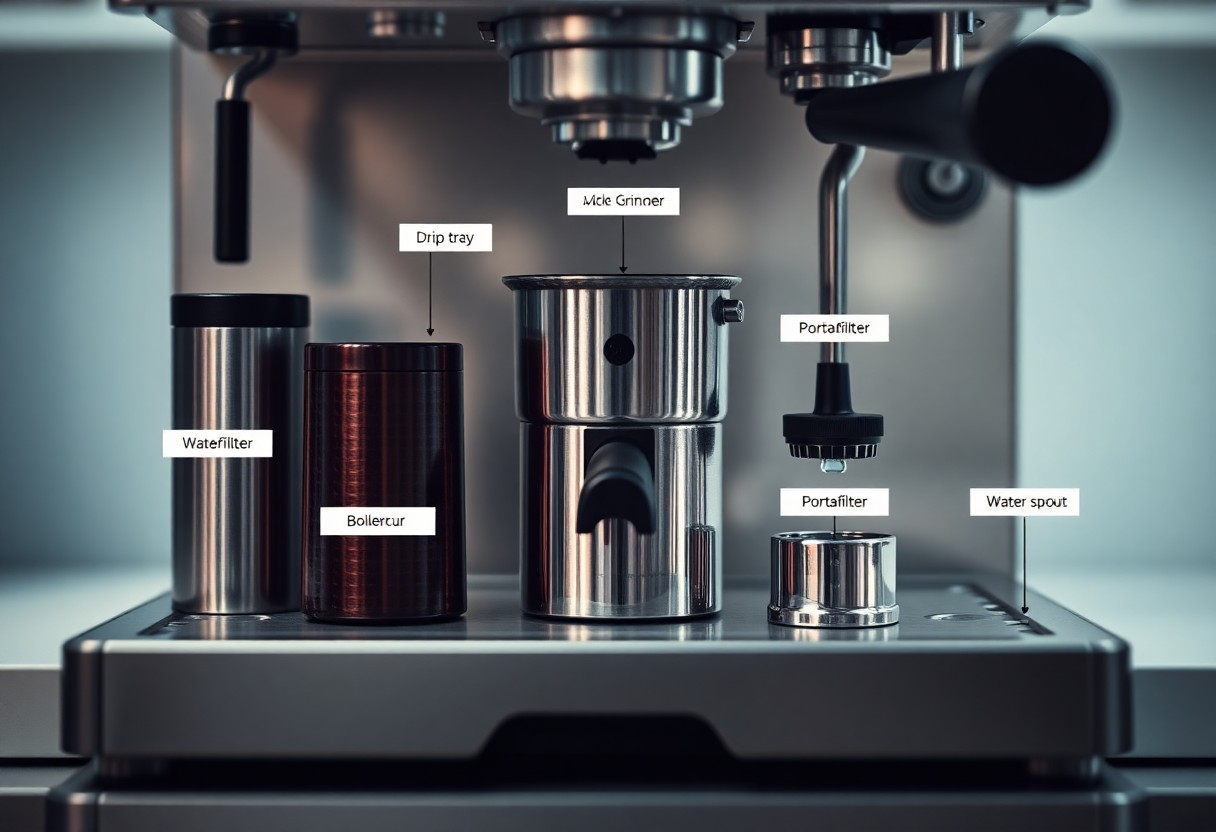
Key Takeaways:
- The main component of a coffee machine is the water reservoir, which holds the water used for brewing coffee.
- The brewing chamber, or brew basket, is where coffee grounds are placed and hot water is mixed to extract flavor.
- The heating element heats the water to the optimal temperature for brewing, ensuring a flavorful cup of coffee.
- The carafe, or coffee pot, is used to collect and store the brewed coffee for serving.
- Additional components may include a drip tray, which catches any spills, and a control panel for operating the machine and setting brewing options.
Dissecting the Coffee Machine: Key Components
Understanding the inner workings of your coffee machine can elevate your brewing experience. Each component plays a significant role in transforming raw beans into the perfect cup of coffee. By breaking down these key parts, you’ll gain insight into how they contribute to the overall functionality and quality of your brew.
The Boiler: Heart of the Brewing Process
The boiler serves as the heart of your coffee machine, generating the steam or hot water needed for brewing. It regulates temperature, ensuring that water reaches the optimal heat for extraction, typically between 190°F and 205°F. This precise temperature range is key to unlocking the full flavor potential from your coffee grounds.
The Pump: Driving Force Behind Coffee Extraction
Your coffee machine’s pump serves as the driving force behind the extraction process. By generating the necessary pressure, typically around 9 bars, the pump helps push hot water through the coffee grounds, facilitating optimal flavor extraction. Without this vital component, achieving that rich, nuanced coffee you love would be nearly impossible.
A high-quality pump ensures a consistent and robust flow of water, allowing for even extraction of flavors from the coffee grounds. In espresso machines, it’s especially vital because insufficient pressure could lead to under-extraction, resulting in a sour taste. Conversely, too much pressure can over-extract, yielding a bitter brew. Investing in a machine with a reliable pump can greatly enhance your coffee experience, giving you the perfect balance between strength and smoothness.
The Portafilter: Gateway to Flavor and Aroma
The portafilter acts as the gateway to the rich flavor and aroma of coffee. It holds the coffee grounds during the brewing process and features a handle for easy maneuvering. Properly packed grounds in a portafilter will significantly influence your coffee’s profile, affecting everything from crema to flavor intensity.
A well-designed portafilter allows for uniform extraction and easy monitoring of the brewing process. Your choice of portafilter—single or double—also impacts your cup’s strength and complexity. To maximize the benefits, ensure your portafilter is clean and properly prepared before each use, as even minor residue can compromise the quality of your brew. Additionally, investing in a quality portafilter can enhance your overall coffee-making experience, providing consistent results with every cup.
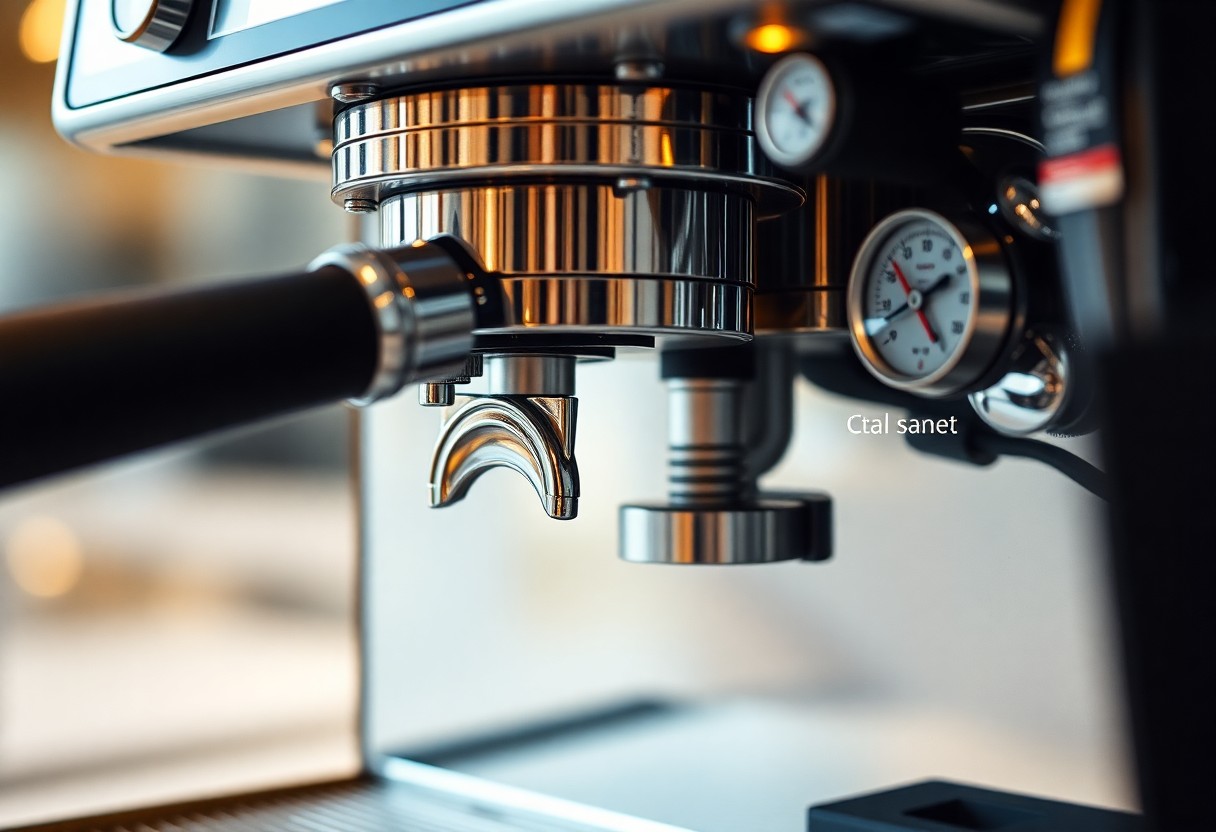
Brewing Mechanics: Understanding the Role of Each Part
Your coffee machine operates through a series of interconnected parts that each play a vital role in producing a perfect cup. Each component works harmoniously to extract flavor, manage temperature, and ensure an enjoyable brewing experience. By understanding the individual functions of these parts, you can better appreciate how they contribute to the overall coffee-making process.
Group Head: The Crucial Connection
The group head serves as the main hub of your coffee machine, where the magic of extraction happens. This component connects the brew water to the coffee grounds, ensuring an even and efficient flow for optimal flavor extraction. The design of the group head can greatly affect your espresso’s taste, making it an crucial element in achieving the perfect brew.
Drip Tray: Balancing Functionality and Design
The drip tray is often overlooked, but it plays a key role in maintaining the cleanliness of your coffee station. It collects overflow liquid, preventing spills and messes, while offering a tidy surface for your coffee machine. The aesthetic design can also enhance your kitchen decor, making it both a functional and stylish component.
A well-designed drip tray not only holds excess liquid but also features removable sections for easy cleaning. Some models even include a level indicator to alert you when it’s time to empty the tray. This balance of form and function allows you to focus on brewing without the constant worry of a wet countertop and helps you maintain your coffee equipment in an appealing manner.
Water Reservoir: The Lifeblood of Your Machine
The water reservoir is the heart of your coffee machine, providing the crucial liquid needed for brewing. Without a sufficient supply of water, your coffee maker simply can’t function. Different machines may feature varying capacities, ranging from compact tanks for single servings to larger reservoirs that can accommodate multiple brews.
Investing in a coffee machine with a larger water reservoir can significantly enhance your convenience, especially if you frequently entertain guests or enjoy multiple cups in a row. Many modern machines also include an easy-to-read fill line or transparent sides, so you can monitor your water levels at a glance. Think of this component as the lifeblood of your coffee experience, directly impacting your ability to brew consistently flavorful coffee without interruption.
Specialized Components: Enhancements and Innovations
Your coffee experience can be taken to new heights with specialized components that enhance functionality and output. Innovations like smart brew technology and integrated scales create a seamless merge between precision and personal preferences in coffee brewing. For a comprehensive understanding of these elements, check out The Complete Guide to Espresso Machine (and Grinder!).
Grinder: The Foundation of Freshness
A high-quality grinder is important for maintaining the freshness of your coffee. The grind size impacts extraction rates, which in turn influences taste. Investing in a burr grinder will allow you to achieve a consistent grind, perfect for your brewing method.
Frothing Wand: Elevating Your Coffee Experience
The frothing wand transforms your coffee by adding a layer of creamy texture and artistry. With proper use, it allows you to create café-style lattes and cappuccinos at home, giving you that rich velvety mouthfeel.
A frothing wand operates by introducing air into the milk, building microfoam that’s crucial for crafting drinks like lattes and cappuccinos. The steam pressure enables the milk to heat evenly while frothing, resulting in an ideal blend of flavor and texture. Mastering the frothing technique can lead to the presentation of beautifully crafted designs, also known as latte art, enhancing your beverage’s visual appeal and enriching the overall experience.
Control Panel: User Experience and Precision Control
Your coffee machine’s control panel provides intuitive access to brewing options, allowing for precise adjustments in temperature, time, and strength. A well-designed interface makes it easier to reproduce your favorite brews consistently.
An effective control panel eliminates guesswork and enhances your brewing prowess. With modern machines, digital displays often provide real-time feedback, letting you customize brewing parameters down to the second. This flexibility ensures that you have complete command over your brew, facilitating everything from simple drip coffee to complex espresso shots, thus enhancing your overall coffee-making process. The incorporation of programmable settings can significantly improve your daily routine by allowing you to pre-set preferred brew times and strengths.
Maintenance Essentials: Caring for Each Component
Ensuring your coffee machine operates efficiently requires dedicated maintenance tailored to each component. By understanding how to care for these parts, you can extend the life of your appliance and enjoy consistently exceptional brews. This involves regular check-ups, necessary replacements, and addressing minor issues promptly to avoid escalating problems that might compromise performance.
Regular Cleaning: Keeping Parts in Peak Condition
Cleaning your coffee machine regularly helps to maintain its functionality and taste quality. For components such as the brew basket, water reservoir, and filter, rinsing or running them through a dishwasher cycle prevents buildup of oils and residues. Additionally, descaling your machine every few months removes mineral deposits, ensuring optimal water flow and flavor extraction.
Troubleshooting Common Component Issues
Identifying and resolving minor issues in your coffee machine can save you both time and money. Watch for signs like unusual noises, inconsistent brewing temperatures, or sediment in your cup. Often, these problems can stem from clogged filters, improper assembly, or insufficient cleaning. Addressing these issues promptly helps maintain the efficiency and longevity of your machine.
For example, if your coffee isn’t brewing at the right temperature, the problem may lie with the heating element. A simple inspection can reveal whether the connections are secure or if the element itself needs replacement. Likewise, if you encounter a sluggish brew process, it could indicate a need for descaling. Maintaining vigilance for these common issues can prevent further complications and ensure a delightful morning brew remains a daily ritual.
The Future of Coffee Machines: Trends and Developments
The coffee machine industry is rapidly evolving, driven by both technological advancements and a growing awareness of environmental impact. Innovations are leading to more versatile, user-friendly devices that not only enhance your brewing experience but also promote sustainability. For those seeking an in-depth look into the components that make these machines tick, explore this guide on the Top 23 Coffee Machine Parts – Name, Image & Their Function.
Smart Technology: Automation and Connectivity
Smart coffee machines are taking the convenience level up a notch. With features such as automated brewing schedules and remote operation via smartphone apps, you can enjoy your perfect cup of coffee with minimal effort. You may also find machines that integrate with home automation systems, allowing voice commands to initiate brewing. These advancements represent a shift towards enhanced consumer control, enabling you to customize your coffee experience like never before.
Sustainability: Innovations Promoting Eco-Friendly Practices
The coffee industry is embracing sustainability in a variety of ways, particularly through eco-friendly machine designs and materials. Many manufacturers are now focusing on energy-efficient brewing systems that reduce waste and energy consumption. Additionally, innovations such as biodegradable pods and recyclable materials for coffee machines create a greener footprint while still delivering quality beverages to you.
Assessing the sustainability of your coffee machine extends beyond its materials; it also encompasses how you maintain and use it. For instance, investing in machines that support eco-friendly coffee pods, which decompose naturally, can significantly lower environmental impact. Landfills are filled with plastic pod waste, but companies are responding with better alternatives that align with your values. Opting for machines boasting energy-saving modes and utilizing locally sourced, sustainable ingredients leads to a more responsible coffee culture, promoting both quality and ethical consumption.
Final Words
Now that you understand the various parts of a coffee machine, including the brewer, carafe, and water reservoir, you can confidently identify each component while using or troubleshooting your machine. Having this knowledge enhances your coffee-making experience and helps you maintain your equipment effectively. As you explore the world of coffee, knowing these parts will make it easier for you to select the right machine and optimize its performance for your daily brew.
FAQ
Q: What are the main components of a coffee machine?
A: The main components of a coffee machine include the water reservoir, heating element, brew basket, filter, carafe, and drip tray. Each part plays a specific role in the coffee brewing process, ensuring that water is heated, coffee grounds are steeped, and brewed coffee is collected.
Q: What is the purpose of the water reservoir in a coffee machine?
A: The water reservoir holds the water that will be heated and used for brewing coffee. It is usually removable for easy filling and cleaning. Some coffee machines have a transparent reservoir to help users see the water level at a glance.
Q: Can you explain the function of the heating element in a coffee machine?
A: The heating element is responsible for heating the water in preparation for brewing. It heats the water to the optimal temperature for extracting flavors from the coffee grounds. Some machines have adjustable settings to allow users to choose their preferred brewing temperature.
Q: What role does the brew basket play in the coffee-making process?
A: The brew basket holds the coffee grounds and is where the hot water flows through to extract flavors. It is often designed to accommodate a filter, which can be either disposable or reusable. Some machines come with a built-in brew basket that simplifies the brewing process.
Q: What is the importance of the carafe in a coffee machine?
A: The carafe is the container that holds the brewed coffee after it has been filtered. Carafes can be made of glass or thermal materials and come in various shapes and sizes. Many coffee machines feature a warming plate beneath the carafe to keep the coffee hot for extended periods.

